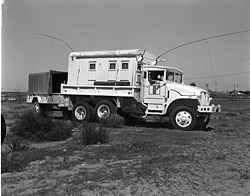AN GRC-26
|
| AN/GRC-26 | |
|---|---|
 AN/GRC-26A being used with UNEF | |
| | |
| Frequency range |
2-18 MHz |
| Power output |
400 Watts |
Communications is achieved on an frequency shift basis over a frequency range of 2 to 18 Mhz. Maximum power output is approximately 400 watts. Facilities are provided for operation of full duplex, half duplex or one way reversible circuits. CW and AM may be used alone or simultaneously with teletype operation. CW and voice can be used in motion or at a halt. For teletype communication it is recommended that the vehicle be brought to a halt. For mobile, one way reversible operation, three whip antennas are used; two for receiving and one for transmitting. Mobile at-the-halt operation normally utilizes whip antennas. If time permits, however, a doublet transmitting antenna should be erected to improve transmitted signal strength. For semi-fixed installations, doublet antennas are used for both transmitting and receiving with two receiving antennas for dual space diversity reception. The internal equipment consists of modified Joint Army/Navy receivers, transmitter, teletype equipment and radio teletype components. Components of the radio teletype equipment are in special, compact, shock mounted cabinets to allow them to be located in a limited amount of space. All operating components are located on tables and shelves in the shelter.
Canada used the AN/GRC-26A during its deployment with the United Nations Emergency Force (UNEF) which deployed to Egypt in 1956. During the deployment with United Nations Operation in the Congo (UNOC), Canada purchased 13 AN/GRC-26D stations.[2]
Related Pages
- No related pages at this time








